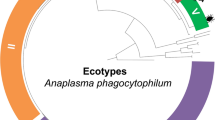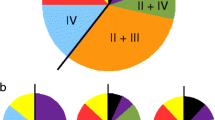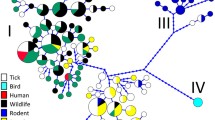Abstract
Anaplasma phagocytophilum is an obligate intracellular bacterium that is transmitted to humans through the bite of Ixodes spp. ticks, and causes a febrile disease known as human granulocytic anaplasmosis. The presence of A. phagocytophilum in Wisconsin white-tailed deer blood and in deer ticks was assessed using PCR and DNA sequencing. Sampling sites in the western part of the state (Buffalo County) and central region (Waushara, Waupaca, and Green Lake counties) were used. In Buffalo County, 5.6% of deer and 8.9% of ticks were infected. At Hartman Creek State Park (Waupaca County), 11.5% of ticks were infected, while the observed prevalence in deer from counties to the south of the park (Waushara and Green Lake) reached 19–26%. Based on 16S rRNA sequences, A. phagocytophilum strains associated and not associated with human infections were identified. Furthermore, two novel A. phagocytophilum variants were found in deer blood samples. Transmission of Lyme disease has been documented in both the Western and Central regions we sampled, and the presence of A. phagocytophilum in naturally occurring tick populations could present an additional risk of disease to humans that enter tick habitats.




Similar content being viewed by others
References
Bakken JS, Krueth J, Wilson-Nordskog C, Tilden RL, Asanovich K, Dumler JS (1996) Clinical and laboratory characteristics of human granulocytic ehrlichiosis. JAMA 275:199–205
Baumgarten BU, Rollinghoff M, Bogdan C (1999) Prevalence of Borrelia burgdorferi and granulocytic and monocytic ehrlichiae in Ixodes Ricinus ticks from southern Germany. J Clin Microbiol 37:3448–3451
Belongia EA, Reed KD, Mitchell PD, Kolbert CP, Persing DH, Gill JS, Kazmierczak JJ (1997) Prevalence of granulocytic Ehrlichia infection among white-tailed deer in Wisconsin. J Clin Microbiol 35:1465–1468
Belongia EA, Reed KD, Mitchell PD, Chyou PH, Mueller-Rizner N, Finkel MF, Schriefer ME (1999) Clinical and epidemiological features of early Lyme disease and human granulocytic ehrlichiosis in Wisconsin. Clin Infect Dis 29:1472–1477
Belongia EA, Reed KD, Mitchell PD, Mueller-Rizner N, Vandermause M, Finkel MF, Kazmierczak JJ (2001) Tickborne infections as a cause of nonspecific febrile illness in Wisconsin. Clin Infect Dis 32:1434–1439
Black WCt, Piesman J (1994) Phylogeny of hard- and soft-tick taxa (Acari: Ixodida) based on mitochondrial 16S rDNA sequences. Proc Natl Acad Sci USA 91:10034–10038
Caporale DA, Johnson CM, Millard BJ (2005) Presence of Borrelia burgdorferi (Spirochaetales: Spirochaetaceae) in southern Kettle Moraine State Forest, Wisconsin, and characterization of strain W97F51. J Med Entomol 42:457–472
Chen SM, Dumler JS, Bakken JS, Walker DH (1994) Identification of a granulocytotropic Ehrlichia species as the etiologic agent of human disease. J Clin Microbiol 32:589–595
Dumler JS, Barbet AF, Bekker CP, Dasch GA, Palmer GH, Ray SC, Rikihisa Y, Rurangirwa FR (2001) Reorganization of genera in the families Rickettsiaceae and Anaplasmataceae in the order Rickettsiales: unification of some species of Ehrlichia with Anaplasma, Cowdria with Ehrlichia and Ehrlichia with Neorickettsia, descriptions of six new species combinations and designation of Ehrlichia equi and ‘HGE agent’ as subjective synonyms of Ehrlichia phagocytophila. Int J Syst Evol Microbiol 51:2145–2165
Finley RW (1976). Original vegetation cover of Wisconsin. University of Wisconsin Madison Cartographic Laboratory
Guerra M, Walker E, Jones C, Paskewitz S, Cortinas MR, Stancil A, Beck L, Bobo M, Kitron U (2002) Predicting the risk of Lyme disease: habitat suitability for Ixodes scapularis in the north central United States. Emerg Infect Dis 8:289–297
Kramer VL, Randolph MP, Hui LT, Irwin WE, Gutierrez AG, Vugia DJ (1999) Detection of the agents of human ehrlichioses in ixodid ticks from California. Am J Trop Med Hyg 60:62–65
Massung RF, Slater KG (2003) Comparison of PCR assays for detection of the agent of human granulocytic ehrlichiosis, Anaplasma phagocytophilum. J Clin Microbiol 41:717–722
Massung RF, Slater K, Owens JH, Nicholson WL, Mather TN, Solberg VB, Olson JG (1998) Nested PCR assay for detection of granulocytic ehrlichiae. J Clin Microbiol 36:1090–1095
Massung RF, Mauel MJ, Owens JH, Allan N, Courtney JW, Stafford KC 3rd, Mather TN (2002) Genetic variants of Ehrlichia phagocytophila, Rhode Island and Connecticut. Emerg Infect Dis 8:467–472
Massung RF, Priestly RA, Miller NJ, Mather TN, Levin ML (2003) Inability of a variant strain of Anaplasma phagocytophilum to infect mice. J Infect Dis 188:1757–1763
Morbidity and mortality weekly report (2003), vol 55, no. RR-4
Parola P, Davoust B, Raoult D (2005) Tick- and flea-borne rickettsial emerging zoonoses. Vet Res 36:469–492
Riehle M, Paskewitz SM (1996) Ixodes scapularis (Acari: Ixodidae): status and changes in prevalence and distribution in Wisconsin between 1981 and 1994 measured by deer surveillance. J Med Entomol 33:933–938
Tate CM, Mead DG, Luttrell MP, Howerth EW, Dugan VG, Munderloh UG, Davidson WR (2005) Experimental infection of white-tailed deer with Anaplasma phagocytophilum, etiologic agent of human granulocytic anaplasmosis. J Clin Microbiol 43:3595–3601
Walls JJ, Asanovich KM, Bakken JS, Dumler JS (1998) Serologic evidence of a natural infection of white-tailed deer with the agent of human granulocytic ehrlichiosis in Wisconsin and Maryland. Clin Diagn Lab Immunol 5:762–765
Zeidner NS, Burkot TR, Massung R, Nicholson WL, Dolan MC, Rutherford JS, Biggerstaff BJ, Maupin GO (2000) Transmission of the agent of human granulocytic ehrlichiosis by Ixodes spinipalpis ticks: evidence of an enzootic cycle of dual infection with Borrelia burgdorferi in Northern Colorado. J Infect Dis 182:616–619
Acknowledgements
The authors would like to thank the many UWO and WSU undergraduates who participated in sample collection, and for the Wisconsin Department of Natural Resources for permission to collect samples. We are indebted to Greg Storch, Louis Magnarelli, Cynthia Tate, Michael Yabsley, Jacob Ijdo, and Diane Caporale for methods development and advice, and to Kimetha Slater and Virginia Bain for their excellent technical assistance. This work was partially funded by a grant from the UWO Faculty Development Program and the NSF REU Sites program. The experiments performed were in direct compliance with current laws of the United States.
Author information
Authors and Affiliations
Corresponding author
Rights and permissions
About this article
Cite this article
Michalski, M., Rosenfield, C., Erickson, M. et al. Anaplasma phagocytophilum in central and western Wisconsin: a molecular survey. Parasitol Res 99, 694–699 (2006). https://doi.org/10.1007/s00436-006-0217-9
Received:
Accepted:
Published:
Issue Date:
DOI: https://doi.org/10.1007/s00436-006-0217-9




